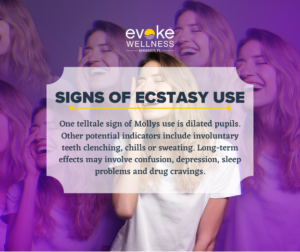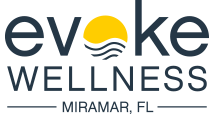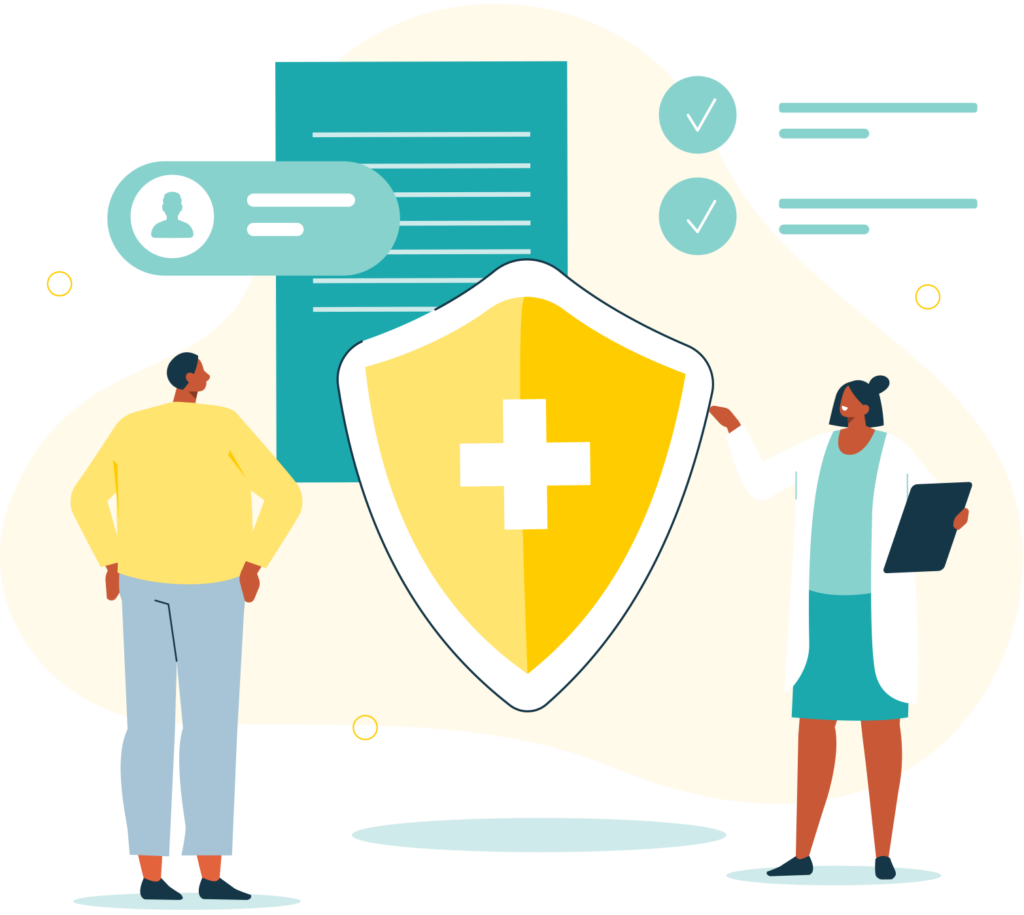When the word “Ecstasy” is mentioned, you may think of the popular club drug MDMA. However, there are important distinctions between Ecstasy and Molly that you should understand, especially when considering addiction treatment. Recent statistics show concerning trends regarding these drugs. This article from Evoke Wellness at Miramar will explore:
- The difference between Ecstasy and Molly
- Addiction treatment options like residential programs
- Dangers of meth, fentanyl, and polysubstance abuse
With knowledge, you can make informed decisions to support your health and wellbeing. Continue reading to learn more.
Together, let’s embrace the journey to recovery and the promise of a new beginning. Call us at (833) 819-6066 today or reach out online.
Introduction
Ecstasy (MDMA) and Molly are often used interchangeably, but they are not the same. While both refer to the synthetic drug MDMA, there are key differences.
What is Ecstasy?
- Ecstasy typically comes in pill or tablet form.
- It often contains fillers, binders, and other unknown substances.
What is Molly?
- Molly is considered the “pure” crystalline powder form of MDMA.
- However, it can still be cut with other substances like bath salts.
Understanding their distinctions is crucial for safety and proper addiction treatment. Evoke Wellness provides comprehensive evidence-based therapies, including:
- Ecstasy addiction treatment
- Polysubstance addiction treatment
- Meth addiction treatment
- Fentanyl detox
- Residential treatment programs
- Extended residential care
- Intensive inpatient treatment
- Outpatient treatment
What Is Ecstasy?
Ecstasy, also known as MDMA (3,4-methylenedioxymethamphetamine), is a synthetic psychoactive drug that acts as a stimulant and hallucinogen. It causes dilated pupils and increases serotonin, dopamine, and norepinephrine levels in the brain, leading to feelings of euphoria, emotional warmth, and heightened energy.
Effects & Dangers
While users may experience a heightened sense of pleasure and emotional closeness, ecstasy also carries significant risks, including:
- Increased heart rate, blood pressure, and body temperature
- Nausea, muscle cramping, teeth grinding
- Long-term mental health issues like depression and anxiety
- Potential neurotoxicity with repeated use
Frequent or high-dose ecstasy consumption can have severe, even life-threatening, consequences. Seeking professional addiction treatment is crucial for overcoming ecstasy dependence safely.
What Is Molly?
The Drug’s Origins
Molly is the street name for MDMA (3,4-methylenedioxymethamphetamine), a synthetic drug chemically similar to stimulants and hallucinogens. Originally developed for therapeutic use, it was later recreationally used for its euphoric effects, earning the nickname “Molly.”
Effects and Dangers
While marketed as “pure” MDMA, Molly often contains unknown additives that increase risks. Its effects include euphoria, increased energy, emotional warmth, distorted senses and heightened pleasure from tactile experiences. However, it can also cause muscle cramps, nausea, blurred vision and severe anxiety.
The Difference Between Molly and Ecstasy
Both Molly and Ecstasy refer to the recreational drug MDMA (3,4-methylenedioxy-methamphetamine). However, there are key differences between the two.
Purity and Composition
- Molly is considered the purer form, containing only MDMA in crystalline or powder form. According to the blog, “Pure MDMA is a crystalline substance.”
- Ecstasy usually refers to pills or tablets containing not just MDMA, but a mixture of other substances like caffeine, amphetamines, or cocaine. As the blog states, “Ecstasy usually refers to pills containing MDMA mixed with other substances.”
Appearance and Branding
- Molly is an unbranded white or colored crystalline powder or rock-like chunks.
- Ecstasy pills come in different colors and are often imprinted with logos or images, as mentioned here: “Ecstasy pills come in different colors and are often imprinted with logos.”
Purity Levels
- While Molly is supposed to be pure MDMA, there’s no guarantee as the blog notes: “Molly is considered a purer form as it only contains MDMA, but its purity also cannot be guaranteed without a lab test.”
- Ecstasy pills have an unpredictable mix, with unknown amounts of MDMA and other additives, making effects vary.
Ecstasy and Molly in Practice
The Party Scene
Ecstasy and Molly thrive in the electronic dance music and rave scene, where their energizing and euphoric effects are sought after. These man-made drugs distort reality and enhance sensory perception.
High Potential for Abuse
However, their intense highs come with significant risks of addiction, overdose, and lasting psychological trauma. Chronic abuse can deplete serotonin levels, causing depression, anxiety, and sleep issues.
Impure and Dangerous
Molly is often marketed as a “pure” form of MDMA, but frequently contains adulterants like bath salts, making it even more hazardous. Both drugs pose serious dangers when combined with alcohol or other substances.
Recognizing the Indicators of MDMA Addiction
Physical Symptoms
- Dilated pupils, blurred vision, chills/sweating
- Nausea, muscle cramping, teeth grinding
- Increased heart rate, high blood pressure
Psychological Signs
- Anxiety, paranoia, confusion, severe mood swings
- Impulsive behavior, depression after use
- Strong psychological cravings, obsession with obtaining more
Social Indicators
- Social withdrawal, isolation from loved ones
- Engaging in risky behaviors, legal problems
- Deteriorating performance at work/school
Despite its reputation as a “party drug,” MDMA (ecstasy/molly) is highly addictive. Recognizing the signs can motivate getting needed treatment before it’s too late. Early intervention is key to avoiding long-term consequences.
Immediate Effects of Molly and Ecstasy
Euphoria and Empathy
After taking MDMA or ecstasy, users often experience an intense euphoric high along with feelings of emotional warmth and empathy. This “lovey-dovey” effect from elevated serotonin levels reduces inhibition and increases sensations, leading many to describe lucid mental processes.
Physical Sensations
MDMA also causes a rapid increase in heart rate and blood pressure, along with nausea, blurred vision, chills, sweating, and tense muscles. Users may experience hyperthermia or overheating, which when combined with dehydration from excessive dancing, can be life-threatening.
Potential Dangers
While the euphoric effects are desirable, MDMA also carries risks of serotonin syndrome from excessive serotonin release. Symptoms include rapid heart rate, high blood pressure, seizures, and organ failure. Long-term MDMA abuse damages brain areas involved in memory, decision-making, and impulse control.
Long-Term Impact of Molly and Ecstasy
Brain Damage and Impairments
Long-term abuse of MDMA/ecstasy can damage the brain and cause cognitive impairments. When consumed, these drugs trigger a chemical reaction releasing dopamine, creating euphoria. Over time, the brain craves more to feel that “reward,” leading to addiction. This often results in decreased cognitive functioning, impairing thinking, memory, decision-making, and learning abilities.
Cardiac Complications
Ecstasy and Molly raise heart rate and blood pressure dramatically. Chronic abuse weakens heart muscles, causes vascular tissue damage, and narrows arteries supplying the heart. Signs of cardiac impact include chest pain, arrhythmias, hypertension, and coronary artery disease due to catecholamine toxicity.
Mental Health Issues
When not taking MDMA/ecstasy, users may experience withdrawal symptoms like tremors, mood swings, and sleep disturbances. This often leads to seeking other substances, causing polysubstance abuse and indicating underlying conditions like depression or anxiety disorders. Effective dual diagnosis treatment is crucial for long-term recovery.
MDMA Addiction and Withdrawal Treatment Options
Comprehensive Treatment Approach
Overcoming MDMA (ecstasy) addiction requires a comprehensive approach addressing physical dependence, psychological factors, and co-occurring mental health issues. At Evoke Wellness, a multidisciplinary team provides personalized treatment plans tailored to each client’s needs. Treatment begins with medical detox to safely manage withdrawal symptoms under 24/7 clinical supervision.
Therapy and Counseling
Once detox is complete, evidence-based therapies like cognitive-behavioral therapy (CBT) and dialectical behavior therapy help clients develop healthy coping mechanisms and regulate emotions. Group counseling, family therapy, and holistic approaches foster a strong support system vital for sustained recovery.
Dual Diagnosis Treatment
MDMA addiction is often accompanied by mental health disorders like depression, anxiety, or trauma. Evoke Wellness’ dual diagnosis programs integrate treatment for substance abuse and any co-occurring psychological conditions through psychotherapy, medication management, and lifestyle changes.
Continuing Care
To prevent relapse, clients transition to outpatient treatment after completing inpatient rehab. Outpatient programs provide ongoing counseling, support groups, and access to community resources fostering lifelong sobriety. Medication-assisted treatment with anti-craving medications may also be integrated into the aftercare plan.
Ecstasy vs. Molly: Frequently Asked Questions About MDMA Addiction Treatment
What is MDMA?
MDMA, also known as ecstasy or molly, is a synthetic psychoactive drug that alters mood and perception. Classified as a stimulant with hallucinogenic properties, it produces feelings of increased energy, euphoria, emotional warmth and distortions in sensory and time perception.
Ecstasy vs. Molly
While ecstasy typically refers to pill form containing MDMA combined with other substances, molly is considered the “pure” crystalline powder form of MDMA. However, molly often contains additives and fillers, making it impure as well.
Dangers of MDMA
MDMA can dangerously increase body temperature, heart rate and blood pressure, dehydrating the body and depleting its salt levels. Long-term effects include confusion, depression, sleep problems and drug cravings. Overdosing can lead to muscle cramps, nausea, faintness and panic attacks.
Treatment for MDMA Addiction
- Detox: Medical detox helps the body clear MDMA and manage withdrawal symptoms like depression, fatigue and drug cravings.
- Therapy: Cognitive behavioral therapy, dialectical behavior therapy and family therapy address psychological dependence.
- Medications: Antidepressants may be prescribed to manage MDMA’s effects on the brain’s serotonin levels.
MDMA addiction treatment requires an integrated, comprehensive approach tailored to each individual’s unique needs. Evoke Wellness at Miramar offers evidence-based treatment programs to help overcome MDMA and polysubstance addictions.
Conclusion
In closing, it’s critical to understand the differences between ecstasy and molly as well as the dangers they pose. While they may seem harmless, recreational use can quickly spiral into addiction. Don’t wait to get treatment. An intensive inpatient or residential program at a reputable rehab provides the comprehensive care needed to overcome addiction and reclaim your life. With customized treatment plans, 24/7 medical supervision, therapy and counseling, you or your loved one can achieve lasting sobriety. Take the first step and contact a treatment specialist today. There are solutions, and a healthy, fulfilling life is within reach.
Begin Your Journey with Evoke Wellness at Miramar
If you or a loved one is considering treatment, Evoke Wellness at Miramar invites you to contact us. Our compassionate team is ready to answer your questions, discuss your needs, and help you take the first steps toward recovery. In Miramar, you’ll find more than just a treatment program – you’ll discover a community dedicated to your wellness and success. Together, let’s embrace the journey to recovery and the promise of a new beginning. Call us at (833) 819-6066 today or reach out online.


